This post was written by Lorraine Finch ACR. Lorraine is an accredited conservator of paper and photographs.
Your photographs are complex chemical objects which are constantly reacting and deteriorating. They are fragile, vulnerable and unstable. Using proper storage materials will reduce the deterioration of your photographs.
You might be wondering what we mean when we talk about storage materials? These are sleeves, boxes, shelves and cabinets that you store your photographs in. We will look at the sleeves and boxes but not the shelves and cabinets.

Unsuitable storage materials ….
It is my experience that most photographic collections are stored in their original boxes, envelopes and plastic sleeves. Usually these storage materials are full to bursting; sometimes to the point where the sleeve or box is tearing and the photographs are falling out. In many cases, I'll find a variety of; rubber bands, paper clips, sticky tapes and other fastening devices. (These should be removed and not replaced.)
These storage materials are unsuitable and can hasten the deterioration of your photographs. Poor quality and/or unsuitable storage materials can introduce a variety of detrimental materials such as:
- acids
- colourants
- alkalis
- sulphur
- lignin
These detrimental materials cause a diverse range of damage. For example, acids can cause your photograph to become brittle, images can fade and yellow as they react with adhesives and colourants can stain photographs.
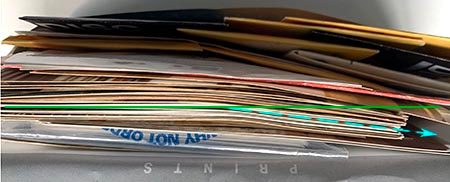
For a range of photographic storage boxes and albums suitable for long term storage - click here.
Unsuitable storage materials can also cause:
- changes to the surface texture of your photograph
- handling damage such as tears and breaks
- marks and indentations
- dust and dirt
Image (right) shows deformation of photographs due to unsuitable storage materials.

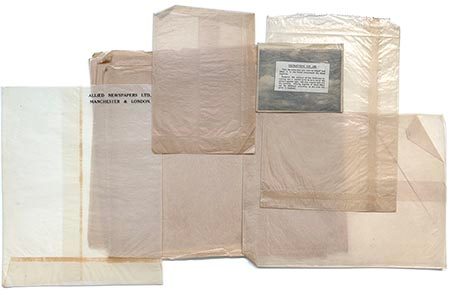 Glassine paper has been used for many years for the storage of negatives and as an interleaving paper in photographic albums. Glassine is a smooth, glossy, semi-transparent paper. Over time glassine becomes acidic, brittle and yellow. It can cause damage to the emulsion of your photographs in the form of indentations. In a flood or even when the air is very damp it can stick to your photograph. If this happens it can be almost impossible to remove.
Glassine paper has been used for many years for the storage of negatives and as an interleaving paper in photographic albums. Glassine is a smooth, glossy, semi-transparent paper. Over time glassine becomes acidic, brittle and yellow. It can cause damage to the emulsion of your photographs in the form of indentations. In a flood or even when the air is very damp it can stick to your photograph. If this happens it can be almost impossible to remove.
New types of glassine paper are available to purchase but they are not recommended for storage with your photographs.
Requirements for storage materials
Photographic conservators are guided by seven International Standards [ISOs] relating to the storage of photographic materials and BS4971:2017 Conservation and care of archive and library collections
Clearly you are not going to read all eight Standards. (I doubt whether most photographic conservators have!)
In general:
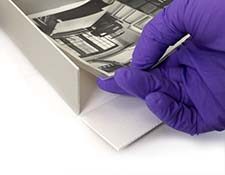
- The material and surface characteristics of the enclosure must not cause scratches and abrasions to the prints and films during storage or use. Ideally, a photographic enclosure should be designed to be removed from the object not one which the object is removed from
- The design of the enclosure should promote safe handling and access to the material
(e.g. drop front boxes or four flap enclosures)
- Materials and adhesives used to make the enclosures should contain no chemicals which could cause or contribute to fading or yellow stain formation
- They must provide adequate protection and should have ageing characteristics that are as good, if not better, than the photographic material
- They must provide adequate physical support to protect the material during handling and to maintain correct storage postures
Quality of storage materials
You can use storage materials made of either paper, board or plastic. As ever, paper, boards and plastics vary in quality and some are acceptable for use with photographic materials and some aren't.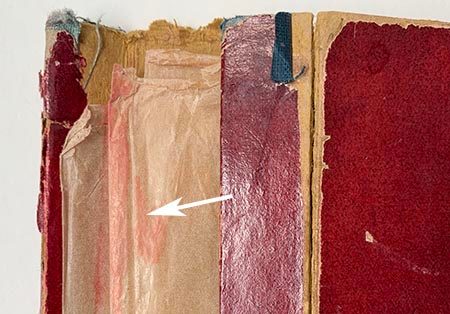
 When you are looking for a storage material that is appropriate for use with your photographs check that it conforms to ISO 18902 (Imaging materials – Processed imaging materials – Albums, framing and storage materials) and that it has passed the Photographic Activity Test [PAT] (ISO 18916 – Imaging materials – Processed imaging materials – Photographic Activity Test for enclosure materials).
When you are looking for a storage material that is appropriate for use with your photographs check that it conforms to ISO 18902 (Imaging materials – Processed imaging materials – Albums, framing and storage materials) and that it has passed the Photographic Activity Test [PAT] (ISO 18916 – Imaging materials – Processed imaging materials – Photographic Activity Test for enclosure materials).
You can view items that have passed the PAT test here.
Storage materials which conform to these standards are generally more expensive; proving the old adage that 'you get what you pay for'.
Image shows staining from an album unsuitable for long term storage
For a range of photographic storage boxes and albums suitable for long term storage click here.
Choosing papers and boards
To help you navigate your way through the complex and often confusing descriptions, look for a paper and/or board which:
- is made with cotton fibres or bleached wood pulp*
- is free from lignin, dyes**, waxes and metallic particles
- is free from sulphur and peroxides
- has a neutral sizing
* If you select a paper or board made from bleached wood pulp you must ensure that it has an alpha cellulose content of 87% or above
** Remember that dyes and colourants can damage your photographs by reacting with silver, gelatine and albumen. This is why you'll find that suitable papers and boards for use with photographic material tend to be off white or cream in tone.
Buffered or unbuffered?
You might have heard of buffered and unbuffered papers. For most library and archive materials buffered paper and boards are recommended. A buffered paper or board is one which contains a substance which neutralises acids. The standard buffering agent used is calcium carbonate. There is much debate in the photographic conservation community about the suitability of using buffered papers and boards. There is a 'list' of photographic processes for which buffered boards and papers are considered 'safe' or 'unsafe' for use with. Further research is required in order to be able to state definitively whether buffered or unbuffered papers and boards should be used with photographs. At the moment the advice is to avoid using buffered papers and boards for cyanotypes, albumen prints and dye transfer and chromogenic prints.
You can view a range of acid free papers and boards here
Choosing plastic envelopes and sleeves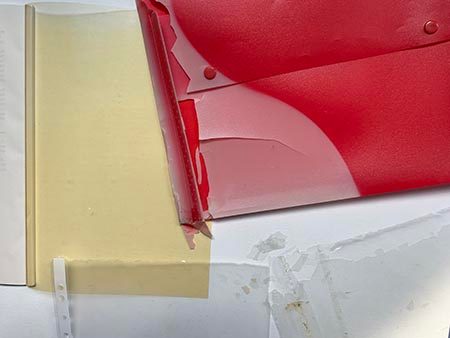
There are two types of plastic that are recommended for use as storage materials for your photographs. These are:
Polyester, and especially polyethylene terephthalate [PET], is used extensively in conservation. Polyester is also known by the trade names Mylar and Melinex. View suitable polyester pockets and sleeves here.
Polyethylene [PE] is less transparent, less durable and less rigid than polyester, but it is less expensive. It is often used when large volumes of photographs need to be housed. View polyethylene photo storage pages here.
Any plastic used should be free from surface coatings.
Other plastics are available, but they all have poor ageing qualities and will eventually damage your photograph. For example; polyvinyl chloride [PVC] has been used, but as it ages it yellows, releases plasticisers causing it to stick to your photographs and produces hydrochloric acid.
Image shows degraded plastic enclosures that contain PVC
That may all seem very complex but it is very important. If you don't know how and why a storage material is damaging your photographs, why would you avoid it. It is also helpful to understand what you are looking for, so you can understand all the technical descriptions that are given.
So now you know what papers, boards and plastics you can use for your photographs, but what do you put in what? For example should you put your glass plates in plastic envelopes, should your prints go into a paper wallet or plastic envelope? Read about that in – Storage Materials for Photographs: Part 2. What, to put in what.
This post was written by Lorraine Finch ACR. Lorraine is an accredited conservator of paper and photographs.
You can contact Lorraine Finch in the following ways: E: paperconservation@btinternet.com | W: www.lfcp.co.uk | T